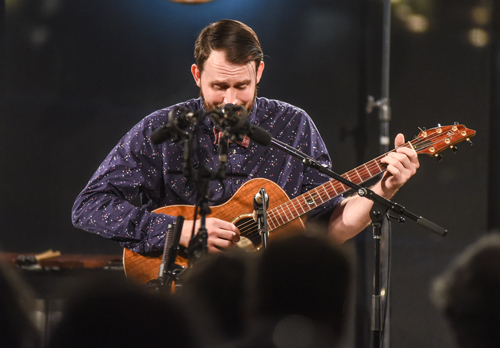by Nicholas Jones

The first act was a Capriccio for three violins by the 19th-century violinist Friedrich Hermann. Written for his students, the piece is light and pleasant but by no means simple, calling for some fancy bow-work and scales that shoot up like rockets. David Bowlin and Jinjoo Cho took the top parts (probably those designed for Hermann’s students), and ChamberFest’s 2015 Young Artist Alexi Kenney played what must have been the teacher’s role, supplying an energetic bass line.
Next up was Steve Reich’s Nagoya Marimbas, a virtuosic duo (yes, two marimbas were brought into the small performance area!) played by Scott Christian and Alexander Cohen. A haunting motif slowly and almost imperceptibly morphed throughout the piece, becoming increasingly complicated as it was tossed between the two players in close canon (that is, the second instrument answers the first, one or two beats later).
The performers in the Reich, as in all the pieces, were amplified. The array of microphones was carefully tended, and the resulting sound was fairly well balanced. Perhaps electronic enhancement was necessary to allow the music to reach the back parts of the Wine Spot. But where I sat, halfway back, I would rather have heard the sound more directly from the instruments and less from the speakers. In some of the pieces, the amplification was too loud for comfort.
After the Reich, Yura Lee (who plays both violin and viola at this festival) took the stage to play the third movement of Zoltán Kodály’s Cello Sonata in B minor, arranged by the performer for solo viola. One can understand why such a fine violist would want to take on this great piece, so full of powerful episodes, alternately folksy and avant-garde. When played on the cello, it pushes the performer (and the instrument) to the limit, encompassing an enormous range of pitches, an equally daunting scope of dynamic and tonal quality, and mixing plucked and bowed notes performed at lightning tempos.
There are many challenges in translating this solo from the cello to the viola, with its smaller resonance and tighter demands on the placement of fingers in the highest passages. Lee’s command of the instrument is inspiring. Despite some intonation problems and a tone that was more strident than it might have been, she gave a savvy, impassioned, and highly committed performance that brought the audience to their feet.
The most memorable performance of the evening featured the third string quartet of Alfred Schnittke. Written in 1983 in a modernist idiom, this work is strangely historically-minded, incorporating motifs from as far back in time as Orlando di Lasso and as near as Shostakovich (the pitches D-Eb-C-B spell DSCH in German notation, which signals his name: D. SCHostakovich). The theme of Beethoven’s Grosse Fuge, Op. 133, recurs throughout the three-movement work and seems to serve as a constant prod to Schnittke’s anxious modernity. It was a joy to hear this rich work played so well by Yehonatan Berick and David Bowlin, violins; Dimitri Murrath, viola; and Clive Greensmith, cello.
Though the order of the concert had been changed, it was clear that after the Schnittke, there was but one more work to go, Giovanni Bottesini’s Grand Duo Concertante, a late 19th-century showpiece for violin and double bass. It was a surprise, then, to see bassist Nathan Farrington appear with only a guitar. Farrington gave us two songs in his pleasant tenor voice. The first was Nemorino’s famous aria from Donizetti’s L’Elisir d’Amore (“Una furtiva lagrima”); the second was in quite another vein — Hank Williams’s “Lovesick Blues.”
Returning with his double bass, Farrington was joined by violinist Alexi Kenney in the Bottesini showcase piece and by a string quartet standing in for the original piano accompaniment. (Bottesini, known in the latter half of the 19th century as “the Paganini of the Double Bass,” is also remembered for conducting the Cairo premiere of Verdi’s Aida.) Spectacular musical fireworks ensued on the part of both soloists for a “grand finale” that reminded us that the Fourth of July is right around the corner.
One doesn’t expect consistency from a “grab bag,” and this one was no exception. The idea was a good one: a chamber festival should honor the various tastes of its performers, some of whom I expect brought these pieces in their suitcases hoping for a hearing. Not everything from a grab bag is a keeper, but there were some very nice prizes in this one.
Photos by Gary Adams.
Published on ClevelandClassical.com June 30, 2015.
Click here for a printable copy of this article







